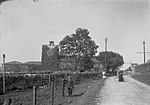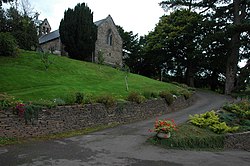Trewyn House
Country houses in WalesDovecotesGrade II* listed buildings in MonmouthshireGrade II* listed housesHouses completed in 1692 ... and 1 more
Registered historic parks and gardens in Monmouthshire

Trewyn House, Llanvihangel Crucorney, Monmouthshire, Wales, is a country house dating from 1692. Its origins are older but the present building was constructed by the Delahayes at the very end of the 17th century when the house sat in Herefordshire. It has since been extended and reconstructed giving an "obscure and complicated" building history. The house is Grade II* listed. The parkland has traces of 17th-century terracing and a rare Grade II* listed dovecote. It is listed Grade II on the Cadw/ICOMOS Register of Parks and Gardens of Special Historic Interest in Wales.
Excerpt from the Wikipedia article Trewyn House (License: CC BY-SA 3.0, Authors, Images).Trewyn House
Geographical coordinates (GPS) Address Nearby Places Show on map
Geographical coordinates (GPS)
| Latitude | Longitude |
|---|---|
| N 51.9001 ° | E -2.977 ° |
Address
NP7 7PG , Crucorney
Wales, United Kingdom
Open on Google Maps









